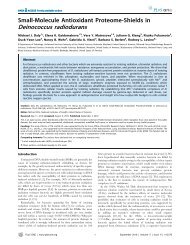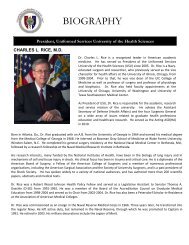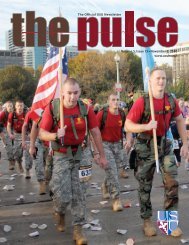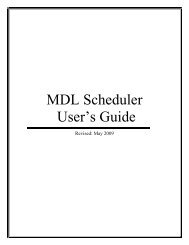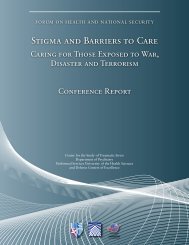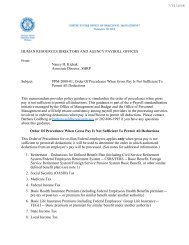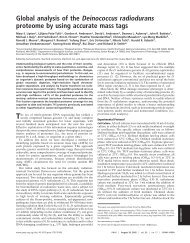- Page 2 and 3:
The Navy SEAL PhysicalFitness Guide
- Page 5 and 6:
About the AuthorsCAPT Frank K. Butl
- Page 7 and 8:
Warfare (SEAL) personnel, U.S. Mari
- Page 9:
An Introduction byRADM Raymond C. S
- Page 12 and 13:
Chapter 2 SEAL Mission-Related Phys
- Page 14 and 15:
Underwater Training 86Varying Your
- Page 16 and 17:
Elements of a Load-Bearing Conditio
- Page 18 and 19:
Summary of Ergogenic Agents 244Prot
- Page 20 and 21:
Table 3-13. Workload Conversion She
- Page 22 and 23:
Table 15-2. Alternate Activities fo
- Page 24 and 25:
Figure 7-4. Recommended Exercise Se
- Page 26 and 27:
Table 0-1. Skill- and Health-Relate
- Page 28 and 29:
Aerobic Metabolism: Most of the ene
- Page 30 and 31:
MET (Metabolic Equivalent Unit): A
- Page 32 and 33:
Type I Muscle FibersType I muscle f
- Page 34 and 35:
Figure 1-1. Muscle Fiber Compositio
- Page 36 and 37:
Measure your heart rate by taking y
- Page 38 and 39:
Figure 1-4. An Example for Determin
- Page 40 and 41:
Table 1-2. Percentage Contributed b
- Page 42 and 43:
if you were exercising continuously
- Page 44 and 45:
" Decrease in maximal aerobic capac
- Page 46 and 47:
Swimming is not the only mission-re
- Page 48 and 49:
Combat Swimmer OperationsWith the c
- Page 50 and 51:
Winter Warfare operations often req
- Page 52 and 53:
Table 2-2. Physical Requirements fo
- Page 54 and 55:
SummaryThe most important types of
- Page 56 and 57:
Basics Concepts ofCardiorespiratory
- Page 58 and 59:
Anaerobic PowerHow much strenuous w
- Page 60 and 61:
" The degree of aerobic training is
- Page 62 and 63:
Table 3-2. Stages and Work Rates fo
- Page 64 and 65:
40 Cardiorespiratory ConditioningHe
- Page 66 and 67:
many challenges. It is also a very
- Page 68 and 69:
" A stroke rate between 24 and 30 p
- Page 70 and 71:
hr, and a moderate workout would be
- Page 72 and 73:
than 35 steps/minute, whereas a hig
- Page 74 and 75:
Other Terms for Work RateOther term
- Page 76 and 77:
52 Cardiorespiratory Conditioning
- Page 78 and 79:
Running GearRunning ShoesA good pai
- Page 80 and 81:
" Cantilever is a concave outsole d
- Page 82 and 83:
If you have high arches you will ne
- Page 84 and 85:
Sometimes low cost, over-the-counte
- Page 86 and 87: Table 4-2. Running Surfaces: From B
- Page 88 and 89: FootstrikeFor most runners, other t
- Page 90 and 91: Figure 4-5. Ways to Increase Runnin
- Page 92 and 93: " After you finish, stretch and wal
- Page 94 and 95: Table 4-5. Frequency of Running Inj
- Page 96 and 97: Open Water GearIn the pure sense th
- Page 98 and 99: Table 5-1. Recommended Fin TypesTyp
- Page 100 and 101: " Getting the best possible fit; tr
- Page 102 and 103: developed guidelines for use of pas
- Page 104 and 105: These are useful to develop the fee
- Page 106 and 107: Figure 5-2 illustrates how the diff
- Page 108 and 109: Freestyle Swim: 10 x 100 m with 45
- Page 110 and 111: Underwater TrainingSwimming underwa
- Page 112 and 113: For beginning freestyle swimmers, a
- Page 114 and 115: Figure 5-7. Side and Front Views of
- Page 116 and 117: " One Arm Freestyle: May be done wi
- Page 118 and 119: Technology has allowed the developm
- Page 120 and 121: The TIME you spend on weight traini
- Page 122 and 123: Determining Repetition MaximumsThe
- Page 124 and 125: Table 6-4. Intensity Levels Relativ
- Page 126 and 127: Table 6-6. Strength Development Pha
- Page 128 and 129: Table 6-8. Week 1: Circuit Training
- Page 130 and 131: Cooling Down andStretchingUpon the
- Page 132 and 133: 108 Strength Training
- Page 134 and 135: alanced physical conditioning progr
- Page 138 and 139: above, when a muscle is slowly stre
- Page 140 and 141: physical activity whether it be str
- Page 142 and 143: Figure 7-4. Recommended Exercise Se
- Page 144 and 145: Table 7-1. Dynamic Stretch Exercise
- Page 146 and 147: Table 7-1. Dynamic Stretch Exercise
- Page 148 and 149: Table 7-2. Static Stretch Exercises
- Page 150 and 151: Table 7-2. Static Stretch Exercises
- Page 152 and 153: Table 7-2. Static Stretch Exercises
- Page 154 and 155: Table 7-2. Static Stretch Exercises
- Page 156 and 157: " Sudy, Mitchell (Ed.). Personal Tr
- Page 158 and 159: Increasing the number of repetition
- Page 160 and 161: A unit's PT schedule should beflexi
- Page 162 and 163: " Incorporate a total body flexibil
- Page 164 and 165: neck into flexion. The fingertips o
- Page 166 and 167: For a 30-minute workout, choose 1 t
- Page 168 and 169: Table 8-2. Recommended Calisthenics
- Page 170 and 171: Table 8-2. Recommended Calisthenics
- Page 172 and 173: Table 8-2. Recommended Calisthenics
- Page 174 and 175: Table 8-2. Recommended Calisthenics
- Page 176 and 177: Table 8-2. Recommended Calisthenics
- Page 178 and 179: endurance. Depending on the fitness
- Page 180 and 181: 156 CalisthenicsTable 8-4. Buddy Ex
- Page 182 and 183: Resources" Gain W., Hartmann J. Str
- Page 184 and 185: Plyometric training is very intense
- Page 186 and 187:
Recommended shoes are those that pr
- Page 188 and 189:
stress on the muscles, joints, and
- Page 190 and 191:
Plyometric TrainingPlyometric train
- Page 192 and 193:
Table 9-3. Plyometric ExercisesExer
- Page 194 and 195:
Table 9-3. Plyometric ExercisesExer
- Page 196 and 197:
Table 9-4. Upper Body PlyometricsEx
- Page 198 and 199:
174 Plyometrics
- Page 200 and 201:
" Physiological and environmental f
- Page 202 and 203:
Figure 10-1. Workload and Energy Ex
- Page 204 and 205:
Lack of sleep can compromise your m
- Page 206 and 207:
" One hump at least every other wee
- Page 208 and 209:
184 Load-Bearing
- Page 210 and 211:
Training in HotEnvironmentsExercisi
- Page 212 and 213:
" Dehydration." Salt depletion." Il
- Page 214 and 215:
" Optimize acclimation by a careful
- Page 216 and 217:
HypothermiaA lowering of body core
- Page 218 and 219:
Training at AltitudeAn athlete’s
- Page 220 and 221:
Acclimation to AltitudeProlonged ex
- Page 222 and 223:
transient and reversible.Although m
- Page 224 and 225:
Treatments for Training-Related Inj
- Page 226 and 227:
Table 12-1. Tips for Applying Ice:
- Page 228 and 229:
" Increased blood pressure." Decrea
- Page 230 and 231:
Return to Mission-Related TasksUlti
- Page 232 and 233:
Sprains and StrainsLigaments attach
- Page 234 and 235:
" A change in shoe wear (worn out s
- Page 236 and 237:
Table 12-5. Musculoskeletal Injurie
- Page 238 and 239:
Running and HikingRunning and hikin
- Page 240 and 241:
over a period of several days. A da
- Page 242 and 243:
218 Training and Sports Related Inj
- Page 244 and 245:
220 Training and Sports Related Inj
- Page 246 and 247:
use of AAS for improved competitive
- Page 248 and 249:
How Anabolic Steroids AlterMetaboli
- Page 250 and 251:
permanent impairment, and some arep
- Page 252 and 253:
Table 13-3. Physiologic Effects of
- Page 254 and 255:
Exercise itself induces these same
- Page 256 and 257:
effects of rEPO are actually simila
- Page 258 and 259:
234 Harmful Substances that Affect
- Page 260 and 261:
Training for SkiingA high skill lev
- Page 262 and 263:
to avoid a recurrence of previous i
- Page 264 and 265:
Table 14-3. A PT Program for High M
- Page 266 and 267:
Table 14-4. Nutritional Ergogenic A
- Page 268 and 269:
Table 14-4. Nutritional Ergogenic A
- Page 270 and 271:
Supplements are a quick and conveni
- Page 272 and 273:
Strength and flexibility are closel
- Page 274 and 275:
Table 15-3. Basic Physical Training
- Page 276 and 277:
Table 15-4. Total Body Physical Tra
- Page 278 and 279:
A Physical Fitness Programfor Comin
- Page 280 and 281:
Table 15-7. Re-Entry Physical Train
- Page 282 and 283:
Table 15-9. Selected Stretching Exe
- Page 284 and 285:
Final Comments From:RADM SmithThis
- Page 286 and 287:
Many of the exercises in the RADM S
- Page 288 and 289:
264 Physical Fitness and Training R
- Page 290 and 291:
Exercise Instruction Diagram3/4 Squ
- Page 292 and 293:
Exercise Instruction DiagramBackCur
- Page 294 and 295:
Exercise Instruction DiagramShoulde
- Page 296 and 297:
Exercise Instruction DiagramBarbell
- Page 298 and 299:
Exercise Instruction DiagramWrist C
- Page 300 and 301:
CommonTerms forMuscle GroupsHip Ext
- Page 302 and 303:
Figure B-2. Selected Muscles of the
- Page 304 and 305:
Figure B-4. Selected Muscles of the
- Page 306:
massage feet, apply foot power, cha



